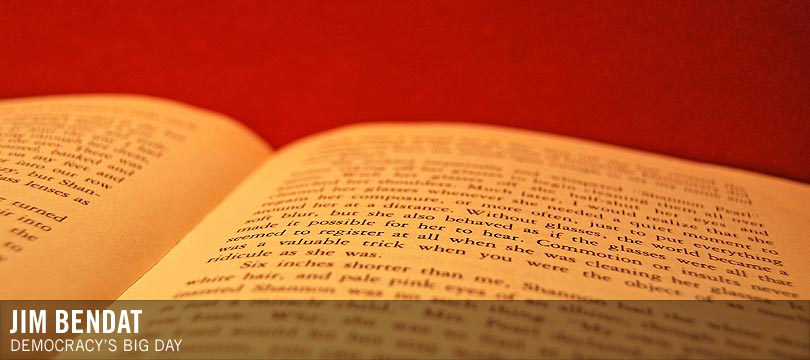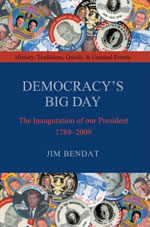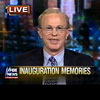

iUniverse was founded in October 1999 and makes it possible for writers to achieve the dream of becoming a published author. With leadership that brings expertise in publishing, sales and marketing and technology, iUniverse offers a unique mix of self-publishing products and services and the skills of a professional team dedicated to enabling authors to see their books in print. By offering a variety of affordable publishing, editorial and marketing services, iUniverse helps authors get their manuscripts off their desks and into the marketplace.
website: www.iuniverse.com
Excerpt from: Democracy's Big Day | Let's Hear it for the Girl
By Jim Bendat
 On March 1, 1929, three days before the upcoming inauguration, Chief Justice William Howard Taft wrote the following note to President-elect Herbert Hoover:
On March 1, 1929, three days before the upcoming inauguration, Chief Justice William Howard Taft wrote the following note to President-elect Herbert Hoover:
I have thought it would be wise to put into written form the details of the ceremony of taking the oath, so that, subject to your approval, you and I shall know what we are to do.
The ceremony will begin behind the stand where the oath is to be taken, you with your back to the Senate, and I with my back to the House. Without any preliminaries, I am to say:
"You, Herbert Hoover, do solemnly swear that you will faithfully execute the office of President of the United States, and will to the best of your ability preserve, protect and defend the Constitution of the United States."
You will then answer "I do."
Sure enough, three days later, as millions of Americans listened to a live radio broadcast of the ceremony, Taft recited the oath and Hoover said just those two words. Those listeners included an eighth-grade history class in Walden, New York. One of the students in that class was thirteen-year-old Helen Terwilliger. Helen had memorized the oath, and she was amazed to hear the chief justice conclude, "preserve, maintain, and defend the Constitution of the United States."
Although no one else had noticed such an error, Helen was certain Taft had mistakenly substituted the word "maintain" for the word "protect." She was so sure, in fact, that she wrote a polite letter to the chief justice in Washington to tell him so.
Taft then wrote back to Helen, "You are quite right that the words of the oath mentioned in the Constitution are ‘preserve, protect and defend,’ but my memory is not always accurate and one sometimes becomes a little uncertain. … It certainly did not prevent the validity of the oath." But the seventy-one-year-old Taft also advised Helen, "You are mistaken in your report of what I did say. What I said was ‘preserve, maintain and protect.’ What I should have said was ‘preserve, protect and defend,’ and you may attribute the variation to the defect of an old man’s memory."
Even after the young critic received this letter from Taft, she stood her ground. She insisted that her version of the chief justice’s mistake reflected what had really taken place in Washington. To settle the issue, the Fox Film Corporation, Pathe News, and Paramount News all checked their inauguration sound films. On March 14, these three organizations unanimously declared that Helen had correctly quoted Taft’s words. Not only had Taft misstated the oath; he had also been mistaken in his recollection of the particulars of his original error. Or, as the New York World reflected on Helen’s accuracy: "She, not the Chief Justice, was right about the way in which the Chief Justice was wrong."
Upon learning the error of his ways, Chief Justice Taft later laughed and said, "I think you’ll have to get along with what I’ve already said. After all, I don’t think it’s important."
When Americans went to movie theaters that week, they got to see and hear the sound newsreel of the ceremony. Then, absolutely everyone knew the truth: little Helen Terwilliger had been right all along.

JIM BENDAT is an inaugural historian and is the author of Democracy’s Big Day: The Inauguration of Our President. He works as a Los Angeles County public defender and has been featured as an inaugural historian by all of the major television networks in the United States, as well as in Canada and the United Kingdom.
Q&A with Jim Bendat
The Arc: How did you become interested in inauguration history?
JB: My interest in the subject stemmed from my being a history buff, as well as a hobby of mine—collecting sports programs. You know, you go to a game; you buy a program. Well, within my program collection, I also had a couple of presidential inauguration programs that I had been given. One day a number of years ago when I discovered Ebay, I typed in the word "inauguration" and a lot of old programs showed up. At first, I just wanted to try to get a Kennedy or a Roosevelt program, for example, to add to my collection. But when I actually began acquiring and reading the old programs, I began to learn lots of terrific stories; great vignettes about inauguration history. It dawned on me that hardly anyone knows that history, and that if I put it together, it could make for a unique and fun book.
The Arc: History books will likely focus on the fact that President Obama is the first black U.S. president. Are there any other unique aspects to his inauguration story that you would like to preserve?
JB: There are really two—one that was large in scope, and one that was really just a footnote. The great story involved the huge throng of people who gathered in Washington on a very cold day to witness history. Everyone who was present got along; there was not a single arrest all day. The overhead pictures of that crowd of people on the National Mall really said it all. The smaller story was the botched inaugural oath by both the chief justice and the new president. It was the first time since 1929 that the oath had been misstated.
The Arc: What is your favorite inauguration story?
JB: In 1923, Calvin Coolidge became president following the death of Warren Harding. At the time of Harding's passing, Coolidge was visiting his father in a small town in Vermont. His father lived in a cottage with no running water, no electricity and no telephone. In the middle of the night, a courier arrived with the news that Harding was dead, and that the attorney general wanted Coolidge to be sworn in immediately. The question was: who was going to administer the oath of office to the new president? The answer turned out to be his own father, who was the local justice of the peace and a notary public. And so, by the light of an old kerosene lamp at 2:47 a.m. on August 3, 1923, John Coolidge swore in his own son as president.










